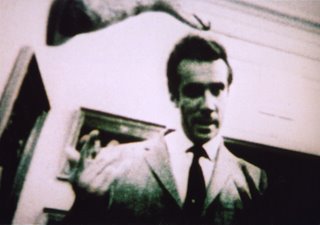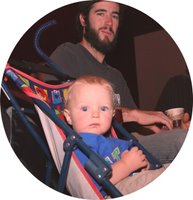
Young Film Enthusiast
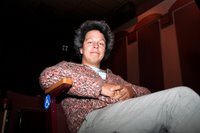
Erwin van't Hart - Filmbank curator archivist from Netherlands
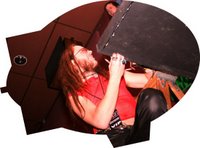
Jason Wade on ladder & Josh in booth window
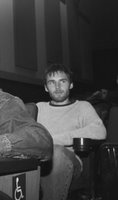

Nick Army

JT Rogstad
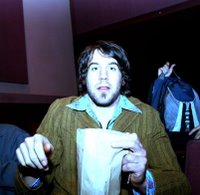
Noah Manos

Young Film Enthusiast

Erwin van't Hart - Filmbank curator archivist from Netherlands

Jason Wade on ladder & Josh in booth window


Nick Army

JT Rogstad

Noah Manos
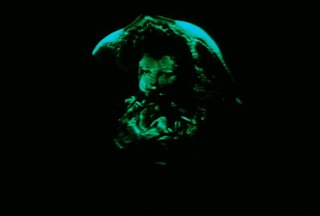
The following program, Where Am I? was a really off-the-wall collection of films. Starting with Gregory Godhard's direct-to-film manipulated A Darkening Slumber, we moved right into one of the most bitter, self-affirming, and personal works of the whole festival, Sandra Davis' amazing anti-medical institution tale of personal survival Ignorance Before Malice. Visually, the work was a combination of repetitious elements: religious iconography, MRI images, and text, which narrated her struggle in the first person while a voice over narrated in the third. All in all a very powerful piece.
The next film, Kerry A. Laitala's Orbit, while not quite as emotionally moving as the previous film, was certainly great to look at. Jorge Lorenzo's Blue-Up took a significantly different approach than almost any other film in the fest, mirroring his conceptual preoccupations with projection (both in the mechanical and psychological sense) and the formal properties of film.
Telemach Wiesinger's Augenblick N 38 came after and featured a high contrast black and white sustained shot of some sort of gooey substance. It was beautiful and came across to me like Jean Cocteau shooting a still life.
Unfortunately I missed almost all of the subsequent program, Freeze Pour Glide Dissolve, although I heard great things about many of the films and from my position just outside the theater (manning the door!), the use of sound especially seemed really interesting in this program. I did catch the first film, Gerard Holthuis' Careless Reef Part 2, which I've seen like 7 times in the past month. It's so awesome and so covertly hilarious, like watching one of the space ship docking scenes from 2001: A Space Oddysey on a lot of cough syrup. Totally rad!
For the second to last program, I got to do some presenting once again, which I don't think came across as well as I would have liked. Regardless, this was one of my favorite programs of the whole event ranging from some assured re-handlings of the hand-manipulated film process to bits of totally beautiful absurdity to a meditation on the exuberance of love.
There's really too much to talk about here, but suffice it to say, Ben Russel presented two completely black and white examinations of symmetrical optics, filmic artificts, and complete psychedelia in his series Black and White Trypps Number(s) 1 and 2. Though I completely adore 1, I was really pleased with how 2 actually looked in a theater.
Michael Robinson's two films, The General Returns From One Place to Another and And We All Shine On dealt with the numerous ways spirituality, heroism, and beauty are mediated, destroyed, or satirized in popular culture. Both films were willfully obscure, surfacey, and painfully touching all at once.
Telemach Wiesinger's second film of the day, Augenblick N 19 was another sumptuous (whoa) b+w still shot. Only this time, there was a sense of austere Japanese aesthetics and an absurdist interest in the two different kinds of planes (not to spoil the surprise).
Jason Livingston's film was brief but stunning, with the overall effect being that of a pet dog's POV on acid in a field of beautiful flowers. And it was all set to a warped version of Sam Cooke's "You Send Me"! Livingston claims the film captures the feeling of being in love and I believe him!
Finally, Dan Baker's gorgeous but somewhat frightening direct-to-film piece wrestled with the problems of "exploration", while I personally found it to be a visionary warning of a post-oil apocalypse. And everyone's entitled to their opinion, right? Right.
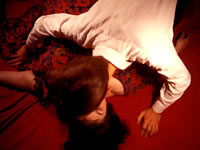
The last film of the entire festival came next, a totally rare showing of old school master Gregory Markopoulos' feature length artsy extravaganza, The Illiac Passion. In some ways mirroring the audience's complete filmic exhaustion at that point, Markopoulos' film combined all manner of well-lit nubile bodies, gay fantasies, complete absurdity, costumed spectacle, and maddeningly repetitious voice over. Truly an ideal choice to end the festival.
After stumbling out of the Starz theater that we had all collectively lived in for the previous 5 days, those of us inclined to do a little imbibing did just that over at Globeville Studios for the 2nd time that weekend. This was a slightly more sedate affair than Friday's party, with no keg, but a decent amount of champagne, cake, and pretzels. Plus, the group I was with brought some "borrowed" liquor! Our plans to check out some cool underground type noisy music following the party were totally stymied but some of us ended up at a diner and finally Chris May's lawn! What a blast! Thanks to everyone who came, spoke, emailed, watched, created, and contributed! You are all beautiful amazing people who will live forever!
-JT Rogstad
[Pics: Ignorance Before Malice by Sandra Davis & The Illiac Passion by Gregory Markopoulos.]

The Luther Price screenings were awesome and I think just about everyone else felt the same way. I have more to say about these later, but for now let's just say Luther Price is a great filmmaker and has quickly become a favorite of mine.
The last screening of the night was Bill Storz's two-hour experimental narrative Beach Beast. Beach Beast was flat out exciting for me, I could almost not handle sitting quiet and still through such a brilliant piece. What's more, Bill was actually there helping project his film, making it that much more special.
-Nick Army
[Pic: Beach Beast by Bill Storz.]
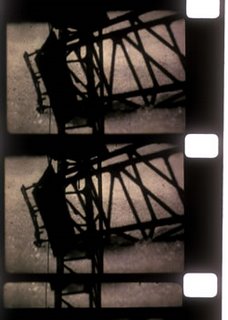
Upon coming up from our lair, we moved back into the main house at Starz for a relatively brief but quite excellent program of 16mm works including an unusual hand-worked film by Jon Behrens contrasting starkly illuminated figures and hand made direct-to-film abstractions. The overall effect was creepy enough to properly prepare us for the following film, Brittany Gravely's Blood of the Earthworm, a half hour of sweeping cultural and political criticism wrapped in a self-consciously free associative, pop ADD anti-horror veneer that remained refreshingly free of cheap irony. Besides being one of the very funniest films of the festival thus far, it was also oddly touching.
Following this great start to the day were a couple of programs that I unfortunately had to miss but heard nothing but good things about since. Apparently Peter Rose's work, which dealt with a lot of text, left quite an impression on many of the viewers.
After what I imagine was another great program, Architectural Acuity, I got back in gear with the abovementioned skinarama program, which kicked off with some found poetry readings by me, followed by Jason Wade's dead-on reimagining of the phallus as a "site" of carnivalesque playfulness and outlandish self-abuse/glorification in My Rancid Cock. It helped that Wade had musical bud in tow, Jon Neilson, to supply some truly epic live distorted tape sounds to accompany the good vibes coming off the gourd in front. "Help me cum!" A more paranoid and overtly body-anxious examination of dicks came next, with Steve McIntyre's Steak Baby. A low budg horror comedy cum (heehee) masculine nightmare, Steak Baby was hilarious and simple enough to be relatively direct if not for all the beautiful little moments of completely wtf humor, including a robot mannacin meat deliverer and a temperamental stuffed cat.
The following film was a not terribly dissapointing mistake, in that we received the wrong Dirt. Originally, Piero Heliczer's avant-garde classic was to show, but instead we got an experimental dance/rape fantasy movie of the same name. It turned out to be nicely fitting with the mood of the program and an interesting counterpoint to the fantasy that came after, Jose Rodriguez-Soltero's narcissistic day dream of longing for gratification. At first the main character finds pleasure in himself but by the end, the filmmaker hints at possibile fulfillment for the individual at the "hands" of another.
Though not nearly as sexually complicated as the previous films, current science professor and former Factory type A. Keewatin Dewdney's Malanga was a triumph in editing alternating scenes of the same character reading and dancing to begin crossing the effects of hearing and seeing. Very mathy and very 60s!
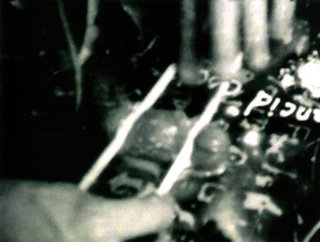
Two films by Paul Bartel closed out the set and though Progretti possibly mystified a lot of people as to its scheduling, the last film, Bartel's cinematic manipulation satire, The Secret Cinema, was a funny and goofy presentation of his and maybe our latent fears of having one's life constructed without our knowledge and of the duplicity of friends in a film-within-a-film world. Sorta creepy, but quite funny as well.
After finally getting out of our silver-screened shrine, we all met over at Globeville Studios for a very swinging art party featuring film projections and drum circles, not to mention the dope cheap beer! If there's anything cooler than sitting around with a bunch of movie dorks it's talking to them while drunk. Plenty of cigarettes were smoked, bonding was done, and hopefully someone got laid, but we've yet to see an experimental film come out of it so who's to say?
-JT Rogstad
[Pics: Blood of the Earthworm by Brittany Gravely & My Rancid Cock by Jason Wade.]

